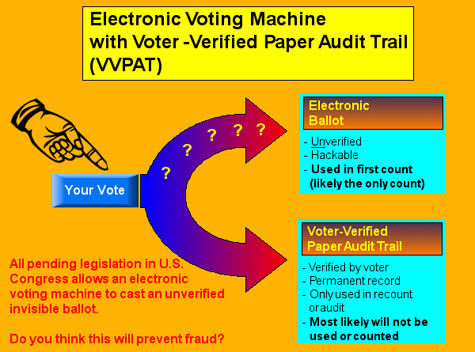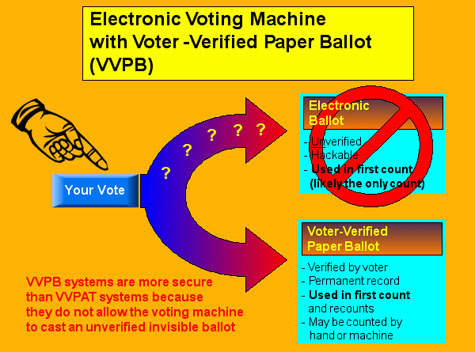With all the pending legislation in Congress designed to fix our electoral system, it is important for concerned citizens to learn and understand just what the bills would require and what they wouldn't.
One key issue is how the various bills attempt to prevent fraud by requiring a "paper trail" on computerized voting machines. In order to understand just how the bills accomplish this, and judge whether or not they solve the problem, it is important to recognize the difference between a Voter-Verified Paper Ballot (VVPB) and a Voter-Verifield Paper Audit Trail (VVPAT).
All the current legislation calls for VVPAT, not VVPB. But does it make a difference?
Here is why the distinction makes a world of difference. Let's start by looking at how an electronic voting machine equipped with a VVPAT printer works. This system is permitted even if the pending legislation is passed. When you cast your vote on one of these systems, two separate things are created — your electronic ballot, which is used to decide who won the election, and your "Paper Audit Trail," which is held in case of an audit or a recount. You are able to view the Paper Audit Trail, and make sure it is correct. You have no way of knowing what your electronic ballot says. You can feel relatively certain that if there is a hand recount, your vote will be counted properly. But since hand recounts are very rare, when you look at that piece of paper, you are not actually verifying your vote. There is still nothing verifying that your actual vote was correct.
The following illustration demonstrates how a VVPAT system works:

In contrast, some legislation on the state level calls for a Voter-Verified Paper Ballot (VVPB). This type of legislation goes a step further, by requiring that the piece of paper is actually used to count the votes in the first count, not merely to be there in case of a hand recount. In fact, VVPB legislation removes one key step in the voting process that is otherwise extremely vulerable to hacking and fraud. DRE (Direct Recording Electronic) voting machines become illegal. The following illustration demonstrates how requiring a VVPB would prevent electronic voting machines from casting an unverified ballot:

The bottom line is that VVPAT legislation aims at making recounts possible, while VVPB legislation focuses more on getting the first count right. Question to reader - after the last 2 elections, how do you feel about relying on recounts to ensure our votes were counted properly?
This demonstrates that the current VVPAT legislation falls short in a key area. However, we should still support the bills. Having at least a possibility of a recount is certainly better than what we have now — nearly 35% of our national vote is paperless and can not be recounted. And that number would likely grow if none of the bills pass. But don't get your hopes up; there is a good possibility the Republicans will prevent these bills from getting out of committee and they may never even be voted on.
Since VVPB legislation is preferable to anyone who cares about the integrity of the voting system, why has not a single Senator or Congressperson at least proposed legislation calling for a paper ballot? We can only wonder.
Things to note
Rush Holt's bill HR550 attempts to address the issue that the VVPATs are not used in the first count, by randomly selecting 2% of the papers and checking them against the votes that were cast by the machines. Many have called into question whether 2% is enough to detect fraud, and as well the question of how to ensure the check is truly random is significant.
This article focuses on one key issue in electronic voting. The reader should not infer that VVPB legislation alone will prevent all computer voting fraud. Legislation that requires a VVPB can still allow for computerized machines to count the paper ballots and central tabulators to total the counts, unless these things are also specifically prohibited in the bill.
One key issue is how the various bills attempt to prevent fraud by requiring a "paper trail" on computerized voting machines. In order to understand just how the bills accomplish this, and judge whether or not they solve the problem, it is important to recognize the difference between a Voter-Verified Paper Ballot (VVPB) and a Voter-Verifield Paper Audit Trail (VVPAT).
All the current legislation calls for VVPAT, not VVPB. But does it make a difference?
Here is why the distinction makes a world of difference. Let's start by looking at how an electronic voting machine equipped with a VVPAT printer works. This system is permitted even if the pending legislation is passed. When you cast your vote on one of these systems, two separate things are created — your electronic ballot, which is used to decide who won the election, and your "Paper Audit Trail," which is held in case of an audit or a recount. You are able to view the Paper Audit Trail, and make sure it is correct. You have no way of knowing what your electronic ballot says. You can feel relatively certain that if there is a hand recount, your vote will be counted properly. But since hand recounts are very rare, when you look at that piece of paper, you are not actually verifying your vote. There is still nothing verifying that your actual vote was correct.
The following illustration demonstrates how a VVPAT system works:

In contrast, some legislation on the state level calls for a Voter-Verified Paper Ballot (VVPB). This type of legislation goes a step further, by requiring that the piece of paper is actually used to count the votes in the first count, not merely to be there in case of a hand recount. In fact, VVPB legislation removes one key step in the voting process that is otherwise extremely vulerable to hacking and fraud. DRE (Direct Recording Electronic) voting machines become illegal. The following illustration demonstrates how requiring a VVPB would prevent electronic voting machines from casting an unverified ballot:

The bottom line is that VVPAT legislation aims at making recounts possible, while VVPB legislation focuses more on getting the first count right. Question to reader - after the last 2 elections, how do you feel about relying on recounts to ensure our votes were counted properly?
This demonstrates that the current VVPAT legislation falls short in a key area. However, we should still support the bills. Having at least a possibility of a recount is certainly better than what we have now — nearly 35% of our national vote is paperless and can not be recounted. And that number would likely grow if none of the bills pass. But don't get your hopes up; there is a good possibility the Republicans will prevent these bills from getting out of committee and they may never even be voted on.
Since VVPB legislation is preferable to anyone who cares about the integrity of the voting system, why has not a single Senator or Congressperson at least proposed legislation calling for a paper ballot? We can only wonder.
Things to note
